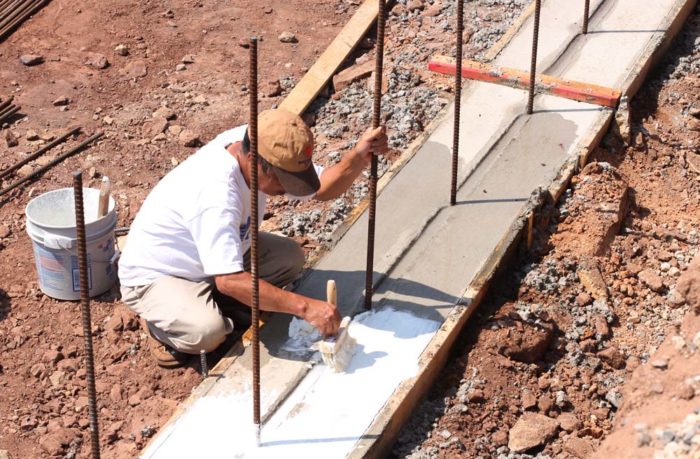
Image Credit: Image #1: Jimmy Nguyen
Builders routinely install several types of barriers to avoid damp basements. Examples of these features include a layer of crushed stone and polyethylene under a basement slab; asphaltic dampproofing on the exterior side of basement walls; and sill seal made of thin closed-cell foam between the top of a foundation wall and the mudsill. All of these materials are used to reduce the transfer of moisture from the damp soil surrounding a foundation to the interior of the building or vulnerable framing lumber.
Even when all of the listed features are installed, however, many builders forget to include a capillary break between the concrete footing and the basement wall. While installing such a capillary break isn’t common practice, it’s important.
About capillarity
If you place a large dry sponge in the middle of a shallow puddle, the top of the sponge soon becomes wet. This is a commonplace occurrence, so most people have an intuitive grasp of how capillary action works. Capillary rise isn’t a phenomenon that is limited to sponges, of course; it also happens with concrete walls, CMU walls, and stone-and-mortar walls.
Capillary rise occurs when the forces of adhesion (the attraction between the molecules of a liquid and those of a solid) are stronger than the forces of cohesion (the attraction of the molecules of the liquid for each other). In some circumstances, equilibrium between these two forces is not achieved until the liquid has risen many feet.
In many houses, capillarity is responsible for the rise of water from damp soil under concrete footings into foundation walls. This phenomenon can contribute up to 15 gallons of water a day to a home’s interior moisture load. Capillary action in soils and masonry — called “rising damp” in Britain — is a function of the…
Weekly Newsletter
Get building science and energy efficiency advice, plus special offers, in your inbox.

This article is only available to GBA Prime Members
Sign up for a free trial and get instant access to this article as well as GBA’s complete library of premium articles and construction details.
Start Free TrialAlready a member? Log in





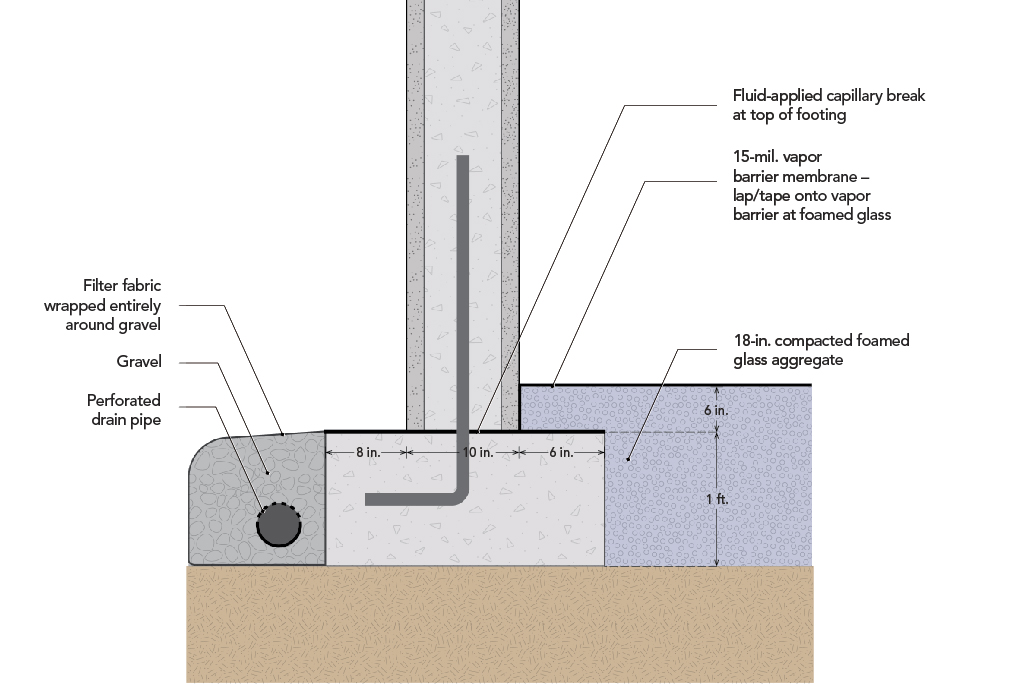
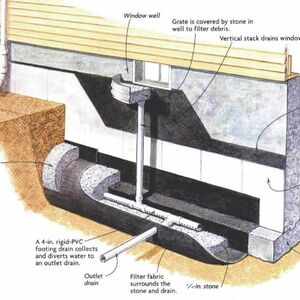
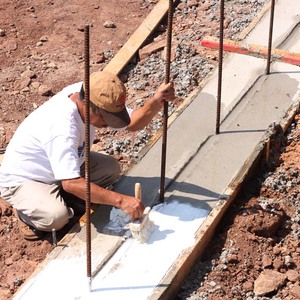
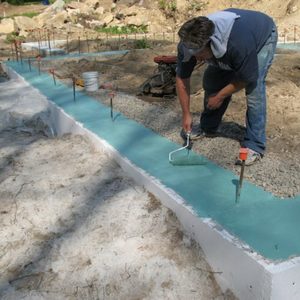






22 Comments
Another Product
I used a water-based, environmentally-friendly product which isn't affected by UV rays (obviously only important for the part of the wall that is above ground). Made in the USA. Looks nice too (again, only important for the part of the wall that is above ground).
http://www.decoproducts.com/deco-20-seal/
It is ICC tested and certified:
http://www.decoproducts.com/wp-content/uploads/2014/02/Deco20SealReport.pdf
Per the website ICC report:
"DECO 20 Seal Waterproofing Membrane shall be
limited to applications on the exterior vertical surfaces
of foundation walls of cast concrete or parged and
nonparged masonry unit construction."
So it seems like it not approved for that use by ICC
Thanks Though
FabForm?
The Fabform system where the footing and the stem wall are a monolithic pour seems like it addresses the capillary issue and several other issues all in one shot. Or am I missing something? Considering using this system on a future house build.
http://www.fab-form.com/fastfootMp/fastfootMpOverview.php
FabForm
It looks like FabForm uses plastic wrapped around the footer. That seems like it's subject to the same concern that Martin expressed about wrapping plastic under the footer. Basically you'd need the plastic good enough to keep it dry if it's sitting in a puddle. I suppose if the plastic is thick enough, it could work, but I didn't spend enough time at that site to see how they seal the seams of the plastic.
Fabform Feedback for Ken
Ken...I would consider minimizing the rising damp from below the footing and accepting less capillary action up the wall a better strategy as opposed to locking it into the footing with a barrier on top...assuming you have the option. I did use Fabform a woven poly product to create footings for a 2600 sq foot ICF garage in BC. I had never build footings and found once I got onto it it was OK to install but I loved it after the pour as I ran it up my ICF wall screwed it into the webs and ran the Soprema peel n stick down overtop. There are no seams to seal. On the interior I ran it up the wall and onto the EPS floor insulation and integrated it into the poly sheet to create a continuous barrier. I would not recommend the monopour other than for a short stem wall and not for any large basement ICF walls as I think from having seen it done there is too much room for errors. I am planning a house in the near future and plan to use Fastfoot again.
Not sure that I would use the Fabform system AND put a coating over the top of the footing as I would rather have the footing have some ability to breathe. BTW...Martin suggested an air source heat pump and underslab insulation 8 years ago as opposed to in-slab radiant and his advice was golden.
Response to Rick Milne
Rick,
I'm glad that my 8-year-old advice was helpful. Thanks for the feedback.
I think we'll have to agree to disagree on one of your points -- "I would consider minimizing the rising damp from below the footing and accepting less capillary action up the wall a better strategy as opposed to locking it into the footing with a barrier on top." Of course, the risk I identified -- the possibility of the footing sitting in a puddle when the holes on the footing drain are located above the bottom of the footing -- will only happen on particularly damp sites. But it can happen.
DELTA®-FOOTING BARRIER
Sorry if this is pushing the edge of excess commercialization, but an excellent off-the-shelf product for the footing-to-foundation wall capillary break is Cosella Dorken Footing Barrier. It is a polyester/polyethylene-based membrane that is pushed into the top of the freshly cast footing. It adheres, because it has a fleece surface--for those who use Schluter Kerdi membrane, I believe it's really similar. Placing the Footing Barrier in place on a wet concrete footing allows for forming of the keyway as well; all of this is much more clear in the video.
DELTA®-FOOTING BARRIER
http://www.cosella-dorken.com/bvf-ca-en/products/foundation_residential/footing_barriers/products/footing_barrier.php
Response to Kohta Ueno
Kohta,
I am aware of the advantages of Delta Footing Barrier, which is why I listed it as a recommended product in the second bullet point of my article. Perhaps you missed the reference.
Delta Footing Barrier was mentioned again in the last sentence of my article.
Response to Kohta Ueno
Whoops--my bad; thanks Martin!
Xypex
The Xypex product is also recommended for application directly to existing basement walls to stop leaks of water. Seems like it would be worth studying in this application if water vapor is not an issue:
http://www.xypex.com/products/coating-products/xypex-concentrate
Response to Catherine Young
Catherine,
I'm aware of the recommended uses of Xypex. But it isn't necessarily true that a waterproofing additive (or a product designed to be applied as a waterproofing coating) will reduce capillary rise when added to concrete.
The only way I know of to test the capillary characteristics of concrete or masonry is to test its capillary behavior.
Fabform System
I used this system on my current build and would never use it again. The fabric is very vulnerable to damage during construction. Just brushing it with a shovel or rake will cause damage. Forget trying to blow gravel into the basement, I had to go around and protect all of the interior surfaces with plywood before moving gravel. Also the sewn corner will leak unless sealed up with P&S membrane. Red sheathing tape should not be used to seal, (vendor recommended), just pulls off (use a high stretch peel and stick). Membrane expands considerably during pour, so you need to estimate additional concrete, as well during the expansion it has a tendency to split any taped seams. It is very easy for the bag to get off centre during pour. I was lucky in that where it was the worst, I had a gable wall with very little load on foundation and so engineer signed off. Vendor will tell you to spike bag to ground, but this is just yet another set of holes you need to try and seal which is very difficult if fabric is expanding during pour. Also easy to get inboard and outboard sides of bag out of sink with one another (when being combined to an ICF situation), this will lead to fairly severe creases in the footing causing a stress riser that can lead to footing failure.
Any hole in the system whatsoever, will defeat it as water will travel a very long distance from the penetration site down the footing and up into the foundation wall. I have been monitoring my 'bags' and often see water between bag and concrete if I let the water level get too high at the build site. If doing again, I would use the embedded membrane and key-way system.
another concrete admixture
I'm surprised there was no mention of Hycrete in this article. Would it not prevent capillary rise?
Response to Don Jennings
Don,
Check out the three paragraphs of my article that follow the heading, "What about admixtures?"
I tried to track down the truth behind the rumor that an admixture called Xypex might limit capillary rise. The manufacturer of Xypex said that they cannot endorse the use of Xypex for this purpose.
You have proposed the use of another additive, Hycrete, for this purpose. Hycrete is sold as a waterproofing additive, and I can see why some people might assume that the product limits capillary rise. But in the absence of data, I'm not going to make any claims about capillary rise in concrete with Hycrete.
Do any GBA readers have data on the issue?
MasterSeal HLM 5000
Any experience out there with MasterSeal HLM 5000 for creating a capillary break?
Epro Ecoline-R
Just thought I'd update my experience with this product, now called E-Roll. I liked the ease of application especially around the rebar dowels, I put down 2 thick coats with a roller and still had some left over for a third. Footing was 2' wide and roughly 210'long.
I also like the fact that it can be used to damp-proof my ICF walls and doesn't effect the foam, which I will be doing with the same product. They actually have a whole system for ICF walls. It comes in 5 gallon pails and cost around $120CDN.
Response to Dave B
Dave,
Thanks very much for sharing your experience with Epro E-Roll.
If I would use sheet membrane instead of fluid-applied, how does someone seal the holes of the sheet membrane if there is rebar installed in the footing. Would you use liquid-applied around the penetrations in the sheet membrane? Or do the sheet membrane manufacturers sell sealers for penetrations?
Anthony,
A capillary break functions like a vapour-barrier in that it works proportionately to the percentage of area it covers, so incidental small holes don't make much difference.
Is there any value in providing a capillary break between bedrock and concrete? The bedrock in this case is granite, which I believe is essentially nonporous, and the wall is bonded directly to the rock – no footing.
As an update to this, I was in touch w/ Henry's. For some of us, unfortunately, a "big box" store is our only option when under a time crunch.
I asked Henry's if their Blue Seal, brushed product could be used on top of green concrete footings as a capillary break.
https://ca.henry.com/waterproofing/waterproofing-systems/blue-seal-icf-and-concrete-construction
Examples of a "big box" carrying it (not a recommendation to shop there):
https://www.homedepot.ca/product/blue-seal-waterproofing-3-78l/1000113877
https://www.homedepot.ca/product/blue-seal-waterproofing-rubber-membrane/1000162969
I received this prompt reply (I really appreciate it when a company stands behind their product and offers quick, useful info):
"Thanks for your interest in Blueseal, yes you can use Blueseal in that application. Let us know if you have any other questions.
Christopher Benoit | Product Support Rep | HENRY COMPANY | 336 Cold Stream Road, Kimberton, PA 19442 | P 800.486.1278 | http://www.henry.com"
For people where things get cold, from the FAQ:
Q: At what temperature should Blue Seal™ Foundation Coating, be applied at?
A: Do not apply Blue Seal™ Foundation Coating when air and surface temperature may go below 2°C (35°F) during the first 72 hours after application
No association w/ Henry's; just someone looking for something quick to put on top of their footings in the next couple of days.
Cheers.
Side note: as every company just seems to be a shell of another company anymore, here are the companies that Henry Canada owns when searching for their products:
https://www.findownersearch.com/owner-henry-company-canada-inc-2095196-company-brands.html
Contact information is shown below including the HENRY COMPANY CANADA, INC. telephone number and the HENRY COMPANY CANADA, INC. website address.
Owner: HENRY COMPANY CANADA, INC.
Owner Address: 15 WALLSEND DRIVE SCARBOROUGH ONTARIO M1E 3X6 Canada
Owner Web Site http://www.usehickson.com
Owner Phone 905-890-4800
Owner Toll Free 1-800-523-0268
Owner Fax 905-890-4866
Brands Owned by HENRY COMPANY CANADA, INC.
Brand:
AQUA-BLOC
Description:
waterproofing chemicals applied to concrete and other building materials
Category: WATERPROOFING CHEMICALS APPLIED
Brand:
AQUALITE
Description:
waterproofing chemical compositions for gypsum and other building materials
Category: WATERPROOFING CHEMICAL COMPOSITION FOR WOOD
Brand:
BAKOR
Description:
insulation adhesives, namely fibrated and non-fibrated asphaltic and resinous-base adhesives for industrial application of insulation to tanks, walls, and roofs
Category: FIBRATED
Brand:
BAKOR
Description:
insulation coatings, namely fibrated and non-fibrated asphaltic and resinous-based coatings for application to insulated mechanical piping, vessels, and tanks; waterproofing coatings, namely fibrated and non-fibrated asphaltic and resinous coatings applied to walls and foundations; and air barrier coatings, namely fibrated and non-fibrated asphaltic and resin-based coatings for application to concrete, concrete block, and drywall sheathing in industrial/commercial rain screenwall applications
Category: CONCRETE BLOCKS
Brand:
BAKOR
Description:
roofing coatings, namely fibrated and non-fibrated asphalt-based coatings for application to concrete decks, insulated decks, and existing asphaltic membranes; and recreational coatings, namely fibrated and non-fibrated asphaltic and plastic-based coatings for application to asphaltic tennis courts and recreational surfaces
Category: EXISTING ASPHALTIC MEMBRANES
Brand:
BLUE SEAL
Description:
WATER PROOFING CHEMICAL COMPOUND FOR SEALING AND WATERPROOFING CONCRETE, MASONRY, POLYMERIC INSULATION BOARD, FOAM, ASPHALT, TILE, WOOD, METAL AND OTHER BUILDING AND CONSTRUCTION SURFACES
Category: WATER PROOFING CHEMICAL COMPOSITIONS
Brand:
BLUE SEAL
Description:
WATERPROOFING CHEMICAL COMPOUND FOR SEALING AND WATERPROOFING CONCRETE, MASONRY, POLYMERIC INSULATION BOARD, FOAM, ASPHALT, TILE, WOOD, METAL AND OTHER BUILDING AND CONSTRUCTION SURFACES
Category: WATERPROOFING CHEMICAL COMPOUND
Brand:
BLUESKIN
Description:
SYNTHETIC RUBBER BASED ADHESIVE PRIMER FOR USE WITH SELF-ADHESIVE MEMBRANES
Category: SYNTHETIC RUBBER BASE PAINT
Brand:
BLUESKIN
Description:
BUILDING MATERIAL, NAMELY PREFABRICATED MODIFIED BITUMEN SHEET MEMBRANE AND EXPANSION JOINT MEMBRANE PRODUCED IN THERMOFUSIBLE, SELF ADHERING AND ADHESIVE GRADES
Category: BUILDING MATERIALS
Brand:
BLUESKINVP
Description:
synthetic non-woven barrier material in the nature of sheets of plastic fabric used as a protective and isolative barrier in building construction
Category: SYNTHETIC NON-WOVEN BARRIER MATERIAL
Brand:
E-Z FLOW
Description:
primer for sealing and priming substrates for flooring underlayment application
Category: PRIMERS
Brand:
E-Z FLOW
Description:
cementitious flooring underlayment
Category: CEMENTITIOUS FLOORING UNDERLAYMENTS
Brand:
EAVEGUARD
Description:
Roofing underlayment
Category: ROOFING UNDERLAYMENTS
Brand:
MODIFIED PLUS
Description:
roofing membrane manufactured in sheet form and composed of a reinforcement fabric which is coated on both sides with a compound consisting of asphalt and rubber polymer
Category: ROOFING MEMBRANE MANUFACTURED IN SHEET
Brand:
POLYBITUME
Description:
polymer modified asphalt
Category: POLYMER MODIFIED ASPHALT
Brand:
PRMA-PLUS III
Description:
waterproofing and roofing material; namely, protected roof membrane and plaza deck assembly consisting of a two-ply reinforced watertight membrane and protection sheet high strength/high moisture resistant extruded polystyrene insulation and pedestals and pavers
Category: PLAZA DECK ASSEMBLY
Brand:
STONE MASON
Description:
chemicals, namely, bonding primers and compounds for concrete repair materials
Category: BONDING PRIMERS
Brand:
STONE MASON
Description:
hydraulic cement, anchoring cement, patching and repairing cement, cementitious based filler, and self-levelling underlayment cement
Category: HYDRAULIC CEMENT
Brand:
STONE MASON
Description:
cleaners for use on concrete, stone and masonry surfaces; and degreasing preparations for use on concrete, stone and masonry surfaces
Category: CLEANERS
Brand:
STONE MASON
Description:
cementitious repair, maintenance and coating products, namely, polymer based sealants for concrete, paving stones, masonry and walls
Category: CEMENTITIOUS REPAIR
Brand:
STONE MASON
Description:
chemicals, namely bonding primers and compounds for concrete repair materials
Category: BONDING PRIMERS
Brand:
STONE MASON
Description:
hydraulic cement, anchoring cement, patching and repairing cement, cementitious based filler, and self-levelling underlayment cement
Category: HYDRAULIC CEMENT
Brand:
STONE MASON
Description:
cleaners for use on concrete, stone and masonry surfaces; and degreasing preparations for use on concrete; stone and masonry surfaces
Category: CLEANERS
Brand:
STONE MASON
Description:
cementitious repair, maintenance and coating products, namely polymer based sealants for concrete, paving stones, masonry and walls
Category: CEMENTITIOUS REPAIR
Brand:
STONE MASON
Description:
CEMENT MIXES
Category: COLORANTS FOR USE AS PAINT
Brand:
STONE MASON
Description:
STENCILS
Category: STENCILS
Brand:
STONE MASON
Description:
CEMENT MIXES
Category: CEMENT MIXES
FYI some of these product uses are not supported by the manufacturer. I was specifically told by some of them not to use it in this application. I'd double check before using.
Log in or become a member to post a comment.
Sign up Log in